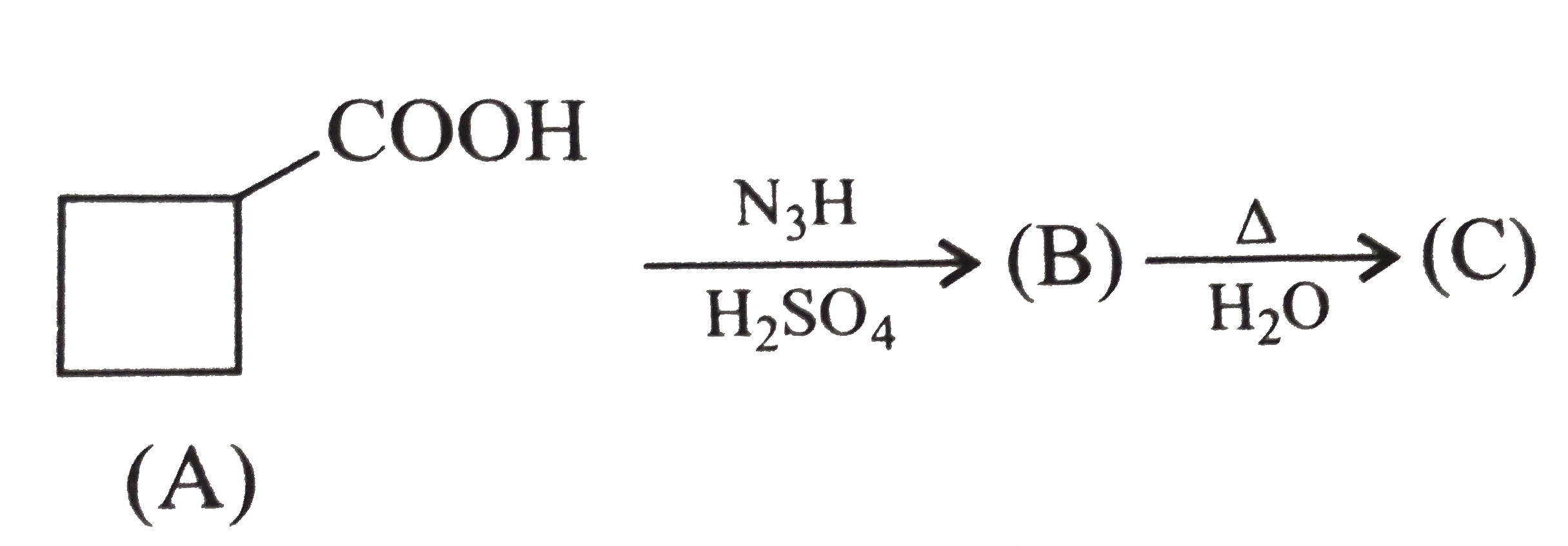Complete the following reaction:
Ar−NH2NaNO2,HCl−−−−−−−−−−→0−5∘CACuCN−−−→B
To complete the given reaction, we will follow the steps outlined in the video transcript.
1. Identify the Starting Material:
The starting material is Ar−NH2, which represents an aromatic amine (an aromatic ring with an amino group).
2. Diazotization Reaction:
When Ar−NH2 is treated with sodium nitrite (NaNO2) and hydrochloric acid (HCl) at a low temperature (0-5°C), a diazotization reaction occurs. This reaction converts the primary amine into a diazonium salt.
- The reaction can be represented as:
\(
Ar-NH2 + NaNO2 + HCl \rightarrow Ar-N2Cl + NaCl + 2H2O
\)
- Here, Ar−N2Cl is the diazonium salt formed (denoted as compound A).
3. Nucleophilic Substitution with CuCN:
The next step involves treating the diazonium salt Ar−N2Cl with copper(I) cyanide (CuCN). In this reaction, the diazonium group (N2Cl) is replaced by a cyano group (CN).
- The reaction can be represented as:
\(
Ar-N2Cl + CuCN \rightarrow Ar-CN + N2 + CuCl
\)
- The product formed from this reaction is Ar−CN (denoted as compound B).
Final Products:
- Compound A: Ar−N2Cl (diazonium salt)
- Compound B: Ar−CN (nitrile)
Summary of the Reaction:
1. Ar−NH2 → Ar−N2Cl (via diazotization)
2. Ar−N2Cl → Ar−CN (via substitution with CuCN)
The starting material is Ar−NH2, which represents an aromatic amine (an aromatic ring with an amino group).
When Ar−NH2 is treated with sodium nitrite (NaNO2) and hydrochloric acid (HCl) at a low temperature (0-5°C), a diazotization reaction occurs. This reaction converts the primary amine into a diazonium salt.
- The reaction can be represented as:
\(
Ar-NH2 + NaNO2 + HCl \rightarrow Ar-N2Cl + NaCl + 2H2O
\)
- Here, Ar−N2Cl is the diazonium salt formed (denoted as compound A).
The next step involves treating the diazonium salt Ar−N2Cl with copper(I) cyanide (CuCN). In this reaction, the diazonium group (N2Cl) is replaced by a cyano group (CN).
- The reaction can be represented as:
\(
Ar-N2Cl + CuCN \rightarrow Ar-CN + N2 + CuCl
\)
- The product formed from this reaction is Ar−CN (denoted as compound B).
- Compound A: Ar−N2Cl (diazonium salt)
- Compound B: Ar−CN (nitrile)
1. Ar−NH2 → Ar−N2Cl (via diazotization)
2. Ar−N2Cl → Ar−CN (via substitution with CuCN)
Topper's Solved these Questions
- ORGANIC COMPOUNDS CONTAINING NITROGEN Book:MODERN PUBLICATIONChapter:ORGANIC COMPOUNDS CONTAINING NITROGEN Exercise:REVISION EXERCISES SHORT ANSWER QUESTIONS
Explore 49 Videos
- ORGANIC COMPOUNDS CONTAINING NITROGEN Book:MODERN PUBLICATIONChapter:ORGANIC COMPOUNDS CONTAINING NITROGEN Exercise:REVISION EXERCISES LONG ANSWER QUESTIONS
Explore 5 Videos
- ORGANIC COMPOUNDS CONTAINING NITROGEN Book:MODERN PUBLICATIONChapter:ORGANIC COMPOUNDS CONTAINING NITROGEN Exercise:REVISION EXERCISES ASSERTION REASON QUESTIONS
Explore 10 Videos
- HALOALKANES AND HALOARENESBook:MODERN PUBLICATIONChapter:HALOALKANES AND HALOARENESExercise:UNIT PRACTICE TEST
Explore 11 Videos
- POLYMERSBook:MODERN PUBLICATIONChapter:POLYMERSExercise:Competition file (OBJECTIVE TYPE QUESTIONS) (C. MULTIPLE CHOICE QUESTIONS)(Integer Type Questions)
Explore 6 Videos
Similar Questions
Identify A, B, C ……. In the following reaction set up.
C6H7HNaNO2−−−−−−−−−→HCl(0∘−5∘C)ACuCl−−→BphCH2Cl−−−−−−→Na/Me2OCNBS−−→D−−−−−−
View SolutionGive the structures of A, B and C in the following reactions :
(a) CH3−COOHNH3/Δ−−−−→ABr2/KOH(aq)−−−−−−−−−→BCHCl3+alc.KOH−−−−−−−−−−−→C
(b) C6H5N+2BF−4NaNO2/Cu−−−−−−−−−→ΔAFe/HCl−−−−→BCH3COCl/pyridine−−−−−−−−−−−→C
(c) C6H5CONH2Br2/aq.KOH−−−−−−−−→ANaNO2+HCl−−−−−−−−−−→0−5∘CBKI−−→C
(d) CH3−ClKCN−−→ALiAlH4−−−→BCHCl3/Alc.KOH−−−−−−−−−−−−−→ΔC
(e) C6H5COO−NH+4Δ−−→ABr2/KOH−−−−−−→BCH3COCl−−−−−−−−→PyridineC
(f) C6H5N+2BF−4NaNO2/Cu−−−−−−−−−→ΔASn/HCl−−−−→BCHCl3+alc.KOH−−−−−−−−−−−→C
(g) ArNH2NaNO2/HCl−−−−−−−−−−→0−5∘CACuCN−−−→B
View Solution
Knowledge Check
The final product in the following reaction sequence is
p - chloroaniline NaNO2,HCl−−−−−−−→0−5∘CKCN?−−−→LiAlH4?−−−−→Ap-chlorobenzamideBp-chlorophenolCp-chlorobenzylamineDp-chlorobenzyl alcoholThe final product in the following reaction sequence is
p-Chloroaniline NaNO2,HCl−−−−−−−−−−→0−5∘C?KCN−−→?LiAlH4−−−→?Ap-ChlorobenzamideBp-ChlorophenolCp-ChlorobenzylamineDp-Chlorobenzyl alcohol. NaNO2−−−−→HCl product?A
NaNO2−−−−→HCl product?A B
B C
C D
D
Identify X, Y and Z in the following reaction :
C6H5NH2NaNO2/HCl−−−−−−−−−−→0−5∘CXH2O/H+−−−−−−−−→WarmYZn−−−−−→HeatZ.
View SolutionIdentify A, B, C and D in the following conversions:
ANaNO2/HCl−−−−−−−−−−→0−5∘CCH3OHPCl3−−→BKCN−−→CLiAIH4−−−−→D
View SolutionComplete the following reactions :
(a)
(b)
( c) Me−COOH(A)NH2OH−−−−→(B)ΘOH−−→(C)
(d)
( e) .
.
View SolutionIdentify Y in the following reaction, C6H5NH2NaNO2/HCl−−−−−−−→280KXCuBr/HBr−−−−−−→Y
View SolutionIdentify the final major product for the following reaction ?
Anline NaNO2+HCl−−−−−−−−→O−5∘CPβ−napthol−−−−−−→Q
View Solution

